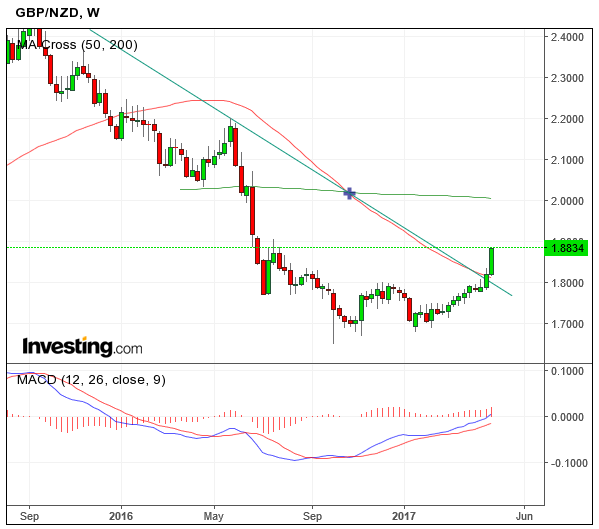Investigating the New Zealand Dollar's Weakness

The New Zealand Dollar has weakened sharply versus the Pound this week, with one pound buying 1.82 Kiwis at the start but the same affording a substantially higher 1.88 at the end.
The Pound is one of the best-performing currencies at present and as such the New Zealand Dollar would naturally be expected to give some ground back.
“Sterling is pushing towards NZD 1.90 and is threatening to test USD 1.30. These are all levels that mark a change of trading ranges and the Pound is battering at the doors of all its major currency partners. If next week’s slew of UK data is as positive as other recent economic news, Sterling could well start May by flexing its muscles again,” says David Johnson of Halo Financial.

But the NZ Dollar is having a tough time against other currencies too, not just Sterling.
There are no obvious big-event catalysts behind the move begging the question what is the underlying driver or drivers behind this sudden bout of weakness?
Strategist’s at Morgan Stanley ask the very same questions with some intriguing insights.
The decline in commodity currencies was thought to be as a result of investors ‘fading’ the Trump reflation trade, argues Morgan Stanley’s Hans Redeker in a note dated April 28.
However, when US rates lept higher it became clear that was not the reason.
One major driver was in fact due to investor concerns about the impact on commodity currencies of the Chinese shift from old industrial model to new services and consumption-based economy.
“Seeing equity markets and US bond yields breaking higher clarified that the commodity decline had little to do with fading the ‘Trump trade’, instead it was being driven by oversupply and China’s economic growth shifting from the ‘old’ commodity-consuming model towards the ‘new’ services sector driven growth,” says Redeker.
Redeker notes how Australia could be especially hit by this transformation in the Chinese economy:
“Economies such as Australia which had invested into exporting into the ‘old’ China should now see their capital returns falling abruptly.”
US trade protectionism is another driver behind the decline after the US placed a tariff on Canadian lumber imports in a response to Canadian restrictions on US dairy imports.
Markets decided that this could be a sign of ‘what’s to come’ and priced in the possibility the same may happen to New Zealand imports to the US.
“The market seems to be increasing its risk premium with regard to the US government putting imports from New Zealand under review too,” says the Morgan Stanley strategist.
Domestic Concerns Key
These are not the main driver for Kiwi weakness, however, stresses Redeker.
“It is about leverage, asset valuation and wage growth in the economies turning lower,” says Redeker.
There is little chance of substantial wage growth now, for example, given the New Zealand economy’s own transition to a more service-based model.
Subdues consumer confidence is also a problem and suggests lower retail sales and spending, which will weigh on GDP.
Another issue is NZ’s foreign liabilities, which are higher than most countries and account for 60% of GDP.
These are essentially foreign loans which are becoming more expensive to service as global interest rates start to rise.
“Foreign balance sheets offer new vulnerabilities as soon as global funding costs increase. Both economies have about 60% of GDP net foreign liability positions, and funding these liabilities at current yield differentials seems difficult, suggesting their currencies will decline,” says Redeker.
NZ’s domestic banking sectors are, “wholesale dependent,” says Redeker, suggesting the rising cost of international capital could impact on them more than other more ‘capital self-sufficient’ countries.
International funding costs are likely to rise steeply if the Federal Reserve were to increase interest rates by as much as many analysts are suggesting.
“Should our view of the Fed hiking another six times prove correct, local cost of funding in Australia and New Zealand will rise even if the RBA and the RBNZ keep their rates unchanged,” says Redeker.
Keep Selling NZD Against GBP
The outlook remains negative for the AUD and NZD from a fundamental perspective, and Morgan Stanley advocate buying GBP/NZD on dips, even though their trade recommendation to go long at 1.78 has now hit its target at 1.87.
Our own target at 1.89 has meanwhile not yet been hit.





